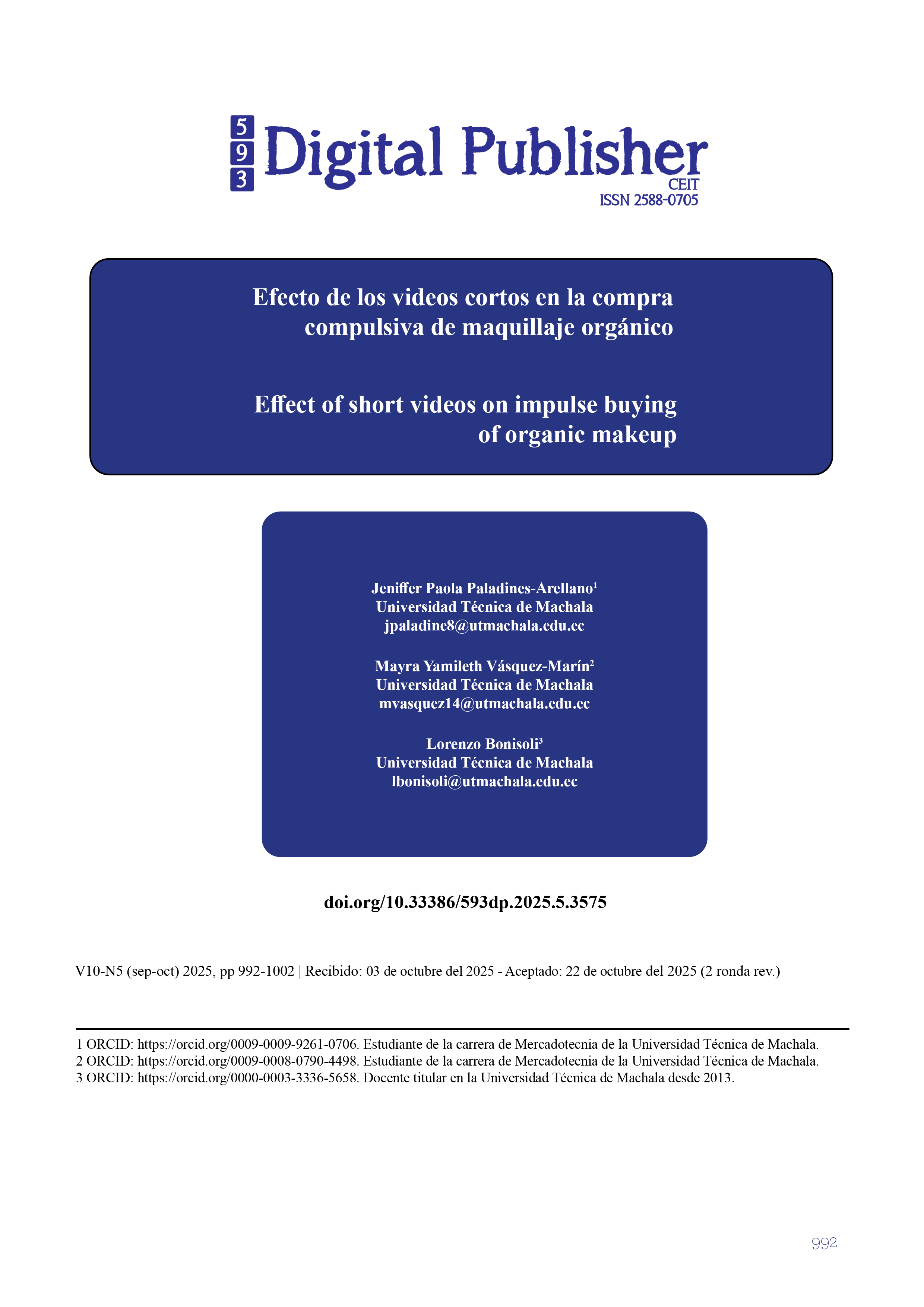Effect of short videos on impulse buying of organic makeup
Main Article Content
Abstract
Compulsive buying in digital environments is an increasingly common phenomenon, driven in particular by the consumption of short videos on social media. By combining entertainment and recommendations, this content can stimulate unplanned purchasing decisions, even in categories related to sustainable consumption.
The aim of this research was to analyze how immediate gratification and surprise influence the compulsive purchase of organic makeup promoted on digital platforms. An exploratory and quantitative approach was applied to 343 young people from Generation Z, using the PLS-SEM technique to evaluate the results.
The findings reveal that the emotions triggered by short videos drive the purchase of eco-friendly products not only for their environmental value, but also for the pleasure and novelty they convey. Surprise was identified as the most decisive factor in the purchase decision, while immediate gratification reinforces the desire to consume quickly and emotionally.
These results offer valuable implications for sustainable cosmetics brands and digital marketing professionals, highlighting the importance of designing audiovisual strategies that channel purchasing impulses toward more conscious and responsible consumption.
Downloads
Article Details

This work is licensed under a Creative Commons Attribution-NonCommercial-ShareAlike 4.0 International License.
1. Derechos de autor
Las obras que se publican en 593 Digital Publisher CEIT están sujetas a los siguientes términos:
1.1. 593 Digital Publisher CEIT, conserva los derechos patrimoniales (copyright) de las obras publicadas, favorece y permite la reutilización de las mismas bajo la licencia Licencia Creative Commons 4.0 de Reconocimiento-NoComercial-CompartirIgual 4.0, por lo cual se pueden copiar, usar, difundir, transmitir y exponer públicamente, siempre que:
1.1.a. Se cite la autoría y fuente original de su publicación (revista, editorial, URL).
1.1.b. No se usen para fines comerciales u onerosos.
1.1.c. Se mencione la existencia y especificaciones de esta licencia de uso.
References
Ardyan, E., & Sanapang, G. M. (2023). Online Compulsive Buying and Brand Addiction in Indonesia: The Importance of Using Fear of Missing Out and Social Commerce Interactivity. The Winners, 24(2), 117–126. https://doi.org/10.21512/tw.v24i2.10817
Arnold, M. J., & Reynolds, K. E. (2003). Hedonic shopping motivations. Journal of Retailing, 79(2), 77–95. https://doi.org/10.1016/S0022-4359(03)00007-1
Bagozzi, R. P., & Yi, Y. (1988). On the evaluation of structural equation models. Journal of the Academy of Marketing Science, 16(1), 74–94. https://doi.org/10.1007/BF02723327
Ciocodeică, D. F., Chivu, R. G., Popa, I. C., Mihălcescu, H., & Barghier, I. (2025). Hedonic and Impulsive Consumer Behavior Stimulated by Social Media: Implications for Sustainable Fashion Marketing. Sustainability (Switzerland), 17(11). https://doi.org/10.3390/su17115198
Crespín, H. J., Fernández, A. N., & Bonisoli, L. (2025). Influenciadores y su efecto en la compra de productos verdes: Un estudio de la generación Z ecuatoriana. Kairós, revista de ciencias económicas, jurídicas y administrativas, 8(14), 46–66. https://doi.org/10.37135/kai.03.14.03
Cronbach, L. J. (1951). Coefficient Alpha and the Internal Structure of Tests. Psychometrika, 16(3), 297–334. https://doi.org/10.1007/BF02310555
Dang, T. Q., Nguyen, L. T., & Duc, D. T. V. (2025). Impulsive Buying and Compulsive Buying in Social Commerce: An Integrated Analysis using the Cognitive-Affective-Behavior Model and Theory of Consumption Values with PLS-SEM. SAGE Open, 15(2). https://doi.org/10.1177/21582440251334215
Dijkstra, T. K., & Henseler, J. (2015). Consistent Partial Least Squares Path Modeling. MIS Quarterly, 39(2), 297–316. https://doi.org/10.25300/MISQ/2015/39.2.02
Dong, W. W., Wang, Y. Q., & Qin, J. (2023). An empirical study on impulse consumption intention of livestreaming e-commerce: The mediating effect of flow experience and the moderating effect of time pressure. Frontiers in Psychology, 13. https://doi.org/10.3389/fpsyg.2022.1019024
Duan, X. (2025). Mental simulation and compulsive buying: a multiple mediation model through impulse buying and self-control. Frontiers in Psychology, 16. https://doi.org/10.3389/fpsyg.2025.1507031
Fornell, C., & Larcker, D. F. (1981). Evaluating Structural Equation Models with Unobservable Variables and Measurement Error. Journal of Marketing Research, 18(1), 39–50. https://doi.org/10.1177/002224378101800104
Gong, X., Yee, C. L., Lee, S. Y., Saif, A. N. M., Liu, M., & Anonthi, F. (2024). Unveiling the enigma of blind box impulse buying curiosity: The moderating role of price consciousness. Heliyon, 10(24). https://doi.org/10.1016/j.heliyon.2024.e40564
Hair, J. F. . (2014). A primer on partial least squares structural equations modeling (PLS-SEM). SAGE.
Hoang, C. C., & Khoa, B. T. (2022). Impulse Buying Behavior of Generation Z customers in Social Commerce: Flow Theory Approach. Journal of Logistics, Informatics and Service Science, 9(4), 197–208. https://doi.org/10.33168/LISS.2022.0413
Huo, C., Wang, X., Sadiq, M. W., & Pang, M. (2023). Exploring Factors Affecting Consumer’s Impulse Buying Behavior in Live-Streaming Shopping: An Interactive Research Based Upon SOR Model. SAGE Open, 13(2). https://doi.org/10.1177/21582440231172678
Jöreskog, K. G. (1971). Statistical Analysis of Sets of Congeneric Tests. Psychometrika, 36(2), 109–133. https://doi.org/10.1007/BF02291393
Kim, J., & Kim, M. (2020). Spectator e-sport and well-being through live streaming services. Technology in Society, 63. https://doi.org/10.1016/j.techsoc.2020.101401
Manizia, L., Borah, T., Bhattacharjee, R., Saikia, J., Dutta, A., & Boruah, J. (2023). Instant Gratification and The Digital Natives: A Pilot Study. Educational Administration: Theory and Practice. https://doi.org/10.53555/kuey.v29i3.7471
Mantik, J., Prasetyo, J. H., & Wiharso, G. (2025). The role of green and digital marketing in driving impulsive buying. In Mantik Journal (Vol. 9, Issue 1). Online.
Moon, M. A., Faheem, S., & Farooq, A. (2022). I, me, and my everything: Self conceptual traits and compulsive buying behavior. Journal of Retailing and Consumer Services, 68, 103075. https://doi.org/10.1016/j.jretconser.2022.103075
Nguyen, T. H. N., Tran, N. K. H., Do, K., & Tran, V. D. (2024). The Role of Product Visual Appeal and Sale Promotion Program on Consumer Impulsive Buying Behavior. Emerging Science Journal, 8(1), 297–309. https://doi.org/10.28991/ESJ-2024-08-01-021
Qu, Y., Khan, J., Su, Y., Tong, J., & Zhao, S. (2023). Impulse buying tendency in live-stream commerce: The role of viewing frequency and anticipated emotions influencing scarcity-induced purchase decision. Journal of Retailing and Consumer Services, 75, 103534. https://doi.org/10.1016/j.jretconser.2023.103534
Rook, D. W., & Fisher, R. J. (1995). Normative Influences on Impulsive Buying Behavior. Journal of Consumer Research, 22(3), 305. https://doi.org/10.1086/209452
Sağtaş, S. (2023). Effects of Flow Experience on Impulse Buying Intent: An Application in E-Retailing. The Journal of International Scientific Researches, 8(3), 478–489. https://doi.org/10.23834/isrjournal.1349827
Streukens, S., & Leroi-Werelds, S. (2016). Bootstrapping and PLS-SEM: A step-by-step guide to get more out of your bootstrap results. European Management Journal, 34(6), 618–632. https://doi.org/10.1016/j.emj.2016.06.003
Tenenhaus, M., Vinzi, V. E., Chatelin, Y.-M., & Lauro, C. (2005). PLS path modeling. Computational Statistics & Data Analysis, 48(1), 159–205. https://doi.org/10.1016/j.csda.2004.03.005
Wang Yilu. (2025). View of Exploring the mechanism of blind box experience marketing driving consumer behavior from the perspective of biological behavioral patterns_ An analysis of the mediating effect of customer surprise. https://doi.org/10.62617/mcb1393
Wu, I. L., Chiu, M. L., & Chen, K. W. (2020). Defining the determinants of online impulse buying through a shopping process of integrating perceived risk, expectation-confirmation model, and flow theory issues. International Journal of Information Management, 52. https://doi.org/10.1016/j.ijinfomgt.2020.102099
Yin, B., & Shen, Y. (2024). Development and Validation of the Compensatory Belief Scale for the Internet Instant Gratification Behavior. Heliyon, 10(1). https://doi.org/10.1016/j.heliyon.2024.e23972




